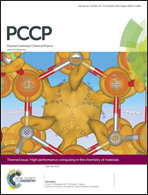Hydration structures of lactic acid: characterization of the ionic clathrate hydrate formed with a biological organic acid anion†
Abstract
Ionic clathrate hydrates are water-based materials that have unique properties, such as a wide range of melting temperatures and high gas capacities. In their structure, water molecules coordinate around ionic substances, which is regarded as the actual hydration structure and also linking of the hydrate clusters, giving insight into the dynamics of the water molecules and ions. This paper reports the synthesis and characterization of the ionic clathrate hydrate of tetra-n-butylammonium lactate (TBAL), the anion of which is a biological organic material. Phase equilibrium measurements and optical observations of the crystal morphology and crystal structure analysis were performed. The TBAL hydrate has a melting temperature of 284.8 K suitable for cool energy storage applications. The actual hydration patterns around a lactate anion are shown in the form of ionic clathrate hydrate structure.


 Please wait while we load your content...
Please wait while we load your content...